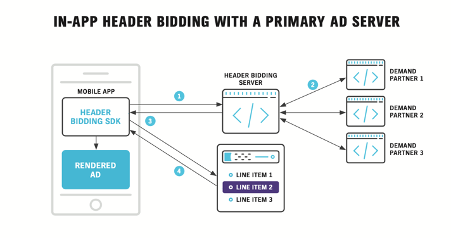Apps are where the eyeballs are going. Consumers downloaded 204 billion apps last year, and for advertisers the rewards can be immense.
Increasingly, programmatic is getting a bigger slice of the in-app pie. Our own recent research shows that programmatic advertising tends to get a larger portion of app advertising budgets. On average, 66% of mobile app ad budgets go to programmatic direct or open exchange strategies, compared to 34% for direct buying.
This creates a huge opportunity for app developers to scale the monetisation and capture the growing brand dollars flowing into in-app, by embracing programmatic selling through header bidding.
So how do they do that? Here is where it gets technical, and an explainer is required.
There are two main types of monetization approaches leveraged by mobile apps: waterfalls and header bidding. Like their web counterparts, waterfalls in the app world can be inefficient, leading to lower yields and poor user experience. In the waterfall system an app developer will typically integrate with several ad network software development kits (SDKs). These SDKs are ordered in priority of who gets the opportunity to return an ad. The developer makes a call for an ad, and the first ad network SDK in the ordered list is given a chance to return an ad. If it fails to fill the impression, then the opportunity to show an ad is passed on to the second, and then the third ad network SDK, and so forth.
Once an ad network fills an impression, the subsequent ad network SDKs are closed out of the monetization process and any possible higher bids from the lower ranked demand sources are never realized. Additionally, having to integrate with multiple ad network SDKs to generate demand leads to SDK bloat and poor app performance.
To solve many of these challenges, app developers have begun adapting the monetization technologies from the web to app environments, leading to a rise in unified auctions for apps (another term for app header bidding).
Header bidding provides publishers with a number of monetization benefits by flattening the waterfall setup. Header bidding (also called “parallel auctions” and “unified auctions”) involves simultaneously collecting multiple bid requests and responses before passing them through to an ad server. With header bidding, publishers can send a single ad impression opportunity to multiple SSPs in parallel, who each, in turn, send that impression opportunity to each of their DSP partners.
This leads to the following benefits for app developers:
- Increased bid density — Header bidding exposes a greater portion of impressions to a buyer (i.e. increasing bid density), greatly increasing the data that DSPs can action and bid on. The increased bid density results in greater competition that increases total revenue.
- Increased fill rate — By adding multiple cloud demand partners, publishers increase the chance of having bids for each ad impression opportunity.
- Increased bid rate — With programmatic demand, it is easy to run floor price testing using real-time CPMs (vs. historical CPM data), leading you to maximum revenue per ad impression opportunity.
- Improved demand optimization — Adding multiple cloud demand partners vs. direct demand partner SDK integrations allows you to scale demand opportunities. Plus, adding or removing cloud-based demand sources does not require changes to your app or app store approvals.
Because of these benefits, header bidding is rapidly becoming a best practice for app publishers that wish to monetize and effectively manage their inventory.
For more information about mobile in-app header bidding, download our white paper here.






